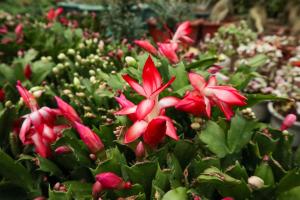Introduction
Poinsettia plants are gorgeous tropical plants that are native to Central America and Mexico. They are popularly used in homes, offices and gardens as festive decorations during the Christmas season. However, even though poinsettias are known for their beauty, they can be quite sensitive, and taking care of them requires some careful attention. In this article, we will take a closer look at how you can take care of a poinsettia plant and keep it healthy all year round.
Choosing a Poinsettia Plant
When selecting a poinsettia plant, it is important to look for one that is healthy, with dark green leaves and a dense, compact shape. Avoid plants that have yellow leaves, or those that appear wilted or droopy. Keep in mind that poinsettias can be quite sensitive to temperature changes and drafts, so it is best to purchase them from a reputable nursery or garden center that can ensure the plant has been properly cared for.
Watering and Feeding
Proper watering is essential for the health of a poinsettia plant. Overwatering or underwatering can both be harmful, so it is important to find the right balance. The best way to water a poinsettia plant is to allow the soil to dry out slightly between watering. When watering, make sure to thoroughly saturate the soil, allowing excess water to drain out. It is also important to avoid getting water on the leaves, as this can cause rot and disease.
Feeding is also important for the health of a poinsettia plant. During the growing season, which typically runs from March through September, you can fertilize your plant every two weeks with a balanced, water-soluble fertilizer. After September, you can reduce fertilization to once a month until the plant goes dormant.
Light and Temperature
Poinsettias need plenty of bright, indirect sunlight to thrive, but direct sunlight can be harmful. Place your poinsettia in a bright room, but keep it away from windows or drafts that can cause heat or cold damage. If the room becomes too warm, you may need to move the plant to a cooler location to protect it.
Temperature control is also important for the health of a poinsettia plant. Poinsettias prefer temperatures between 60 and 70 degrees Fahrenheit during the day and 55 to 60 degrees Fahrenheit at night. Exposure to temperatures outside of this range can cause plant stress and premature leaf loss.
Keeping Poinsettias Alive Year-Round
While poinsettias are often treated as disposable plants, with many people discarding them after the holiday season, they can actually be kept alive and healthy for years with the proper care. After the blooms have faded, you can prune the plant back to about 8 inches, and continue to water and fertilize it regularly. In the spring, once the danger of frost has passed, you can repot the plant into a larger pot, and move it outside. In the fall, bring the plant back indoors, where it can overwinter in a cool, bright location.
Conclusion
Poinsettia plants are stunning additions to any home or garden, but taking care of them requires attention to detail and dedication. By following these tips for proper watering, feeding, light and temperature, you can ensure that your poinsettia plant remains vibrant and healthy year-round. With a little bit of care, your poinsettia can become a cherished part of your holiday traditions for many years to come.

 how many times do yo...
how many times do yo... how many planted tre...
how many planted tre... how many pine trees ...
how many pine trees ... how many pecan trees...
how many pecan trees... how many plants comp...
how many plants comp... how many plants can ...
how many plants can ... how many plants and ...
how many plants and ... how many pepper plan...
how many pepper plan...






























